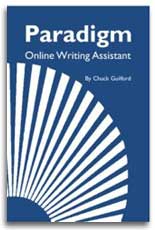The beginning and end of your essay are positions of high emphasis. They deserve careful attention. Keep them short and purposeful. Use them to create and satisfy expectations. Get into the habit of reading your introduction and conclusion together, with an eye toward revision, as one of the last stages in your writing process.
If you sometimes have trouble with introductions and conclusions, you may find the following suggestions useful.
Introductions
First impressions are often lasting impressions. This is true in life, and especially in writing. Your readers' first judgments, even if mistaken, about the value of the topic, your skill as a writer, and your character as a person have a strong impact on their total response to your work.
Here you take the first steps toward building a strong relationship, one that will last at least for the rest of the paper.
If you get off to a good start, readers may stick with you through the rough spots, forgiving an occasional error or concentrating extra hard when you explain a complex idea. On the other hand, if readers don't think your topic's important or do think you're uninformed, overly sentimental, or sarcastic, they'll keep those impressions until you show them false. Your paper may even be set aside, unread.
It might be helpful, therefore, to think of your introduction as a first meeting with your readers. Here you take the first steps toward building a strong relationship, one that will last at least for the rest of the paper.
If you see your introduction this way, you'll see also that no single pattern or format can meet the demands of every writing situation. Therefore, regard the suggestions below as exactly that-suggestions. In some situations they may not be helpful, but in others, for a particular purpose or reader, they may offer exactly the right approach.
Focus Your Reader's Attention
... reach beyond your personal perspective for the common ground you share.
Just because readers are people, they have individual interests, viewpoints, preoccupations, and needs. Your memo on staff reorganization may come across your supervisor's desk just before an important luncheon meeting when she's hungry and a bit edgy. She may not have been thinking much about the change you proposed last week, and what she has been thinking may not have been in line with your ideas. In such a situation, you need to try seeing things from her point of view. You must reach beyond your personal perspective for the common ground you share. Having shown that you're sensitive to, and perhaps even share, the reader's needs, you'll be well poised to state your ideas.
Because this type of introduction gradually moves from a broad concern with general issues to a narrower range of interest stated in a thesis sentence, it's often referred to as a "funnel." Notice how the following introduction focuses attention on the thesis:
During the past year our sales have grown well beyond the level projected in last April's report, A Regional Marketing and Sales Strategy. This success demonstrates that we have a good product, a strong marketing plan, and an effective sales force in the field. Now, as planning for the coming year begins, it's time to consider how we can implement this strategy on a national level.
Begin with a Fact or Example
By now, you understand the importance of concrete, specific details in your paper's body. Details can also be strong ways of opening and closing, as they give your reader a concrete, specific connection to the subject.
Last July, Duke, a four year old Labrador retriever, was dragged behind a pickup truck on a rope and left to die on the desert. Fortunately, he was found and taken to the Humane Society where his wounds were treated and he was gradually nursed back to health. Eventually, he was adopted by Bill and Linda, a young couple who say they couldn't imagine finding a better pet. Not all stories of animal abuse end as happily as Duke's, but the Humane Society works hard to help all animals in distress, and it deserves your support.
Note a Common Misconception
If your readers were fully informed on your subject, they wouldn't be need to read your essay. So, whether their misconceptions are due to lack of information, failure to draw valid conclusions from factual information, or some other reason, it's often helpful to acknowledge misunderstandings at the start. In doing so, you show you're aware of other views, and also show why your paper is important: to correct these mistaken ideas, to bring about better understanding.
When I first tell people that I grew up without a father, they often express sympathy. It's true that I never had a dad to play catch with or teach me to fish, but I played catch with friends and learned to fish on my own. Actually, I found that growing up in a single parent family has several advantages.
The sense of opposition generated by this type of introduction creates tension, and in doing so, sharpens and dramatizes your ideas.
Raise a Question
Explanations often begin when we try to answer a question or solve a problem, and a thesis statement, especially in the early stages of writing, is often a tentative answer to a question that you want to explore. Why not share the question with your readers and invite them to join the search for an answer?
Like many people my age, I limit my cholesterol intake, but recently I've learned that some cholesterol can actually be healthy for me. What exactly is cholesterol, and what does it do? How can I tell whether the cholesterol in a salmon steak is good or bad for me? To maintain a healthy blood cholesterol level, we should all understand what this chemical compound is and how it works in the human body.
Make a Bold Assertion
Another way to say this might be: Go out on a limb. Take a risk. Of course, this approach can be overdone and can lead to exhibitionism and sensationalism, especially if you're writing in a context that demands restraint and moderation. In those situations, this "Look, ma! No Hands!" approach could be a disaster.
The new fall television lineups are out, and they look like the same old trash: more violence, more insipid sitcoms, more hackneyed plots and one-dimensional characters. This is mind pollution, pure and simple. The American people deserve better programming from the major networks.
Activity
6.17 Write three different introductory paragraphs for one of your essays. Exchange and discuss them with a partner. What are the strengths and weakness of each introduction?
Conclusions
Although some writers find them difficult, conclusions need not be a problem, especially if you've been working toward a goal throughout your essay. As you near the end of your paper, you might ask a few basic questions. So what? What does all this finally have to do with anything, anyway? What do I most want my readers to take away from this essay? What do I hope they'll do now that they've read this? What last thoughts do I want to imprint on their minds before we part company?
If you remember that your conclusion should provide finality and closure, you won't open up a new subject and leave your reader hanging.
Often your instincts will tell you what needs to be said, worked through, made clear, at the end. If you remember that your conclusion should provide finality and closure, you won't open a new subject and leave readers hanging. If you recall that endings are always positions of great emphasis, you won't leave your reader with a mere supporting fact from one of your sub-points.
Keeping such principles in mind and also being careful not to repeat what you've already discussed, you should sense how best to end, and your reader should agree.
Activity
6.17 Write a short paragraph discussing the conclusion of one of your essays. Why did you end in this way? In what other ways did you consider ending? Why did you reject them? How do you feel about the ending you finally wound up with? Exchange your paragraph and the corresponding essay with a partner and discuss them.




